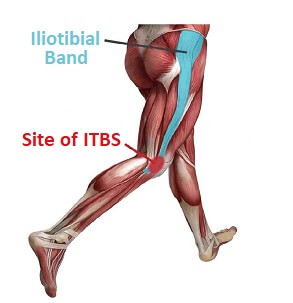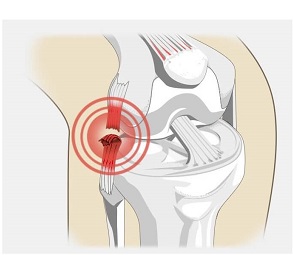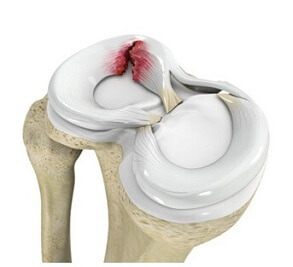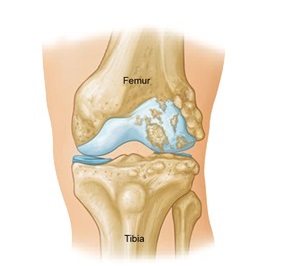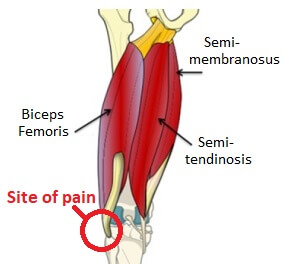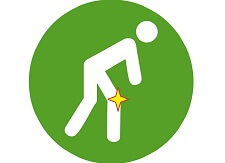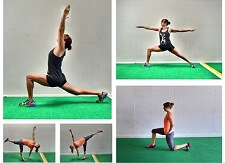- Home
- Knee Pain Diagnosis
- Lateral Knee Pain
Lateral Knee Pain
Written By: Chloe Wilson, BSc(Hons) Physiotherapy
Reviewed by: KPE Medical Review Board
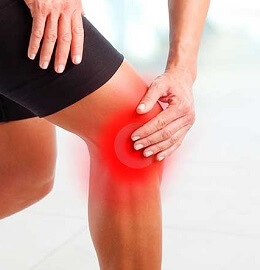
Lateral knee pain is pain that occurs on the outside of the knee. It may come on gradually over time or may develop suddenly after an injury. As a result, the symptoms are varied too.
Outer knee pain may be a general ache or specific sharp pain and movement may be restricted. It may or may not be connected to a specific activity.
The outer side of the knee is the least common place to experience knee pain. In most cases, localised outer knee pain is due to an injury affecting one of the structures on the outside of the knee.
Lateral knee pain is often accompanied by swelling on the outside of the knee, particularly if one of the structures has been torn.
Causes Of Lateral Knee Pain
Here we will look at the most common causes of lateral knee pain, what causes them, the typical symptoms and how to treat them. At the end we will look at the common causes of outer knee pain by activity.
By far, the most common cause of lateral knee pain is iliotibial band syndrome so let's start there.
1. Iliotibial Band Syndrome
Irritation of thick fibrous band on outer thigh. IT Band Syndrome is the most common cause of outer knee pain
Causes: overuse, muscle tightness and weakness, running, flat feet, sudden increase in activity
Symptoms: Pain on outside of knee, worse with running, esp when heel strikes the floor, cycling, squats, stairs, hiking
Full Article: IT Band Syndrome
2. LCL Injury
Overstretching and tearing of the lateral collateral ligament on the outer side of the knee
Causes: Sudden twisting or awkward fall where the lower leg is forced inwards, a blow to the inside of the knee
Symptoms: Instability, swelling, bruising and outer knee pain, worse when bending the knee, walking, on stairs or with sports
Full Article: Knee Ligament Injuries
3. Lateral Meniscus Tear
A tear in the thick cartilage lining the outer side of the knee joint
Causes: Sudden onset from awkward knee twisting esp if knee bent and foot planted. Gradual onset from wear and tear
Symptoms: Lateral knee pain, locking (knee gets stuck), instability, difficulty straightening the knee
Full Article: Knee Cartilage Tears
4. Lateral Knee Arthritis
Wear and tear of the outer side of the knee joint, bone spur formation, loss of joint space, inflammation
Causes: Wear and tear, aging, previous knee injury or surgery, obesity
Symptoms: Dull, nagging achy pain in the knee, stiffness (particularly in the morning) and creaky/noisy knees
Full Article: Knee Arthritis
5. Hamstring Tendinopathy
Damage and tearing to the lateral hamstring tendon, biceps femoris, causing inflammation and degeneration
Causes: Overuse, repetitive jumping or kicking, sports where there is a lot of acceleration and deceleration work
Symptoms: Tender to touch, pain on outside of knee at the back, worse with resisted knee flexion.
Full Article: Hamstring Tendonitis
Rare Causes Of Lateral Knee Pain
There are a few other possible causes of outer knee pain. These are much less common but should not be forgotten.
1. Proximal Tibiofibular Joint Dislocation
Proximal tibiofibular joint dislocation is one of the most unusual causes of lateral knee pain. It affects the joint between the top of the shin bone (tibia) and the fibular, the small, thin bone that runs down the outer side of the shin, just below the knee joint on the outer side.
It takes a large force to dislocate the joint, e.g. a car accident, but it can also partially dislocate (sublux) usually due to a fall when the foot is plantarflexed (toes pointing down), which often also damages the tibiofibular ligament.
Symptoms usually include outer knee pain, instability especially during deep squats and sometimes an obvious deformity at the side of the knee. There may also be associated damage to the peroneal nerve leading to pins and needles or numbness around the outer knee.
2. Nerve Problems
Pressure along the path of the peroneal nerve can also cause outer knee pain. The peroneal nerve branches off from the sciatic nerve and runs down the outer side of the lower leg to the foot.
Nerve pain is often associated with tingling, pins and needles and or numbness. Whilst there may be pain on outside of knee there is usually no swelling with nerve problems. A common cause of lateral nerve pain above the knee is meralgia paresthetica.
Damage to the peroneal nerve usually occurs when there is a blow to the side of the knee, which squashes the nerve where it sits just below the skin. Alternatively, there may be pressure higher up the nerve where the sciatic nerve branches off from the lower part of the lumbar spine e.g. from a disc protrusion.
The pain can refer (travel) down the nerve and may result in pain on outside of knee, with or without associated back pain. Again, there will often be neurological symptoms as well such as tingling and/or numbness.
3. Trochanteric Bursitis
Irritation and inflammation of the trochanteric bursa, small fluid filled sac, located on the outer side of the hip can cause pain that radiates down the outer thigh to the knee.
Trochanteric bursitis is typically caused by repetitive stress and friction on the bursa from repetitive hip movements e.g. cycling or running, a direct blow to the side of the hip, muscle tightness and weakness in the glutes and ITB, biomechanical issues such as leg length discrepancies or with sudden increases in activity levels.
Trochanteric bursitis pain is usually focused around the outer hip, which gets worse with hip movement or when lying on your side. This pain can radiate down the lateral thigh and cause outer knee pain.
Lateral Knee Pain By Activity
Lateral Knee Pain From Running: The most likely cause of outside knee pain running is IT Band syndrome, inflammation of the band down the outerside of the thigh. With iliotibial band syndrome, it is really important to rest from aggravating activities otherwise the condition can become chronic. This may mean reducing training time or stopping running altogether for a period of time. If the pain is more at the back of the knee, then it is probably due to hamstring tendonitis.
Lateral Knee Pain With No Swelling: Outside knee pain no swelling implies an overuse or degenerative condition rather than a soft tissue injury such as a ligament sprain or meniscus tear. Outer knee pain without swelling is often a chronic problem such as knee tendonitis, IT Band Syndrome or Runners Knee
Pain On Outside Of Knee With Flexion: Outer knee pain when bending the knee often indicates a problem in the hamstrings as they are responsible for knee flexion, most likely hamstring tendonitis. If the pain is more central, it is likely to be a problem with the kneecap such as patellofemoral pain syndrome.
Lateral Knee Pain With Full Extension: Pain on outside of knee when you straighten the leg is often caused by something getting stuck inside the knee joint, typically from a cartilage injury or arthritis. Outer knee pain with extension is often accompanied by locking where the knee gets stuck.
Outer Knee Pain When Squatting: later knee pain squatting tends to happen when there is a problem in the knee cartilage meaning it doesn't provide adequate cushioning of the knee joint, typically a meniscus tear and knee arthritis.
Lateral Knee Pain Going Down Stairs: Outer knee pain coming down stairs is often associated with Iliotibial Band Syndrome or lateral collateral ligament injury. If the pain is more central, it is likely a problem with the kneecap.
Outside Knee Pain And Instability: Outer knee pain that is accompanied by weakness and giving way at the knee typically indicates a knee ligament tear, most likely of the ACL or an LCL injury.
Pain On Outside of Knee Radiating Down Leg: If your outer knee pain spreads down your leg anymore than a couple of inches, then chances are that the problem isn't actually in your knee at all, but most likely in one of the nerves in the leg. Nerve pain is usually associated with abnormal sensations such as tingling or numbness
Lateral Knee Pain With Swelling: Gerenalised swelling around the outer knee is usually caused by knee arthritis, lateral meniscus tear or a moderate to severe LCL tear. If there is a more defined pocket of swelling, it may be due to an LCL sprain, ITB syndrome or lateral plica syndrome. Find out more in the Swelling On Side Of Knee article.
Outer Knee Pain Treatment
The best course of treatment for lateral knee pain will depend on the underlying cause of the outer knee pain. It will usually include a combination of exercises, physical therapy and rest from aggravating activities and may also include knee injections and surgery.
To find out more about these common causes of pain on outside of knee and how to treat them, use the links above or if there is significant swelling, visit the Swelling On Side Of Knee article to find out what is wrong and how to treat it.
If you would like some help working out what is causing your outer knee pain using other specific symptoms, how the pain started or the specific location of the pain, visit the knee pain diagnosis section and learn what you can do about it. Remember, any new incidence of lateral knee pain should always be assessed by your doctor.
You might also be interested in the following articles:
- Knee Pain & Popping
- Swollen Knee Treatment
- Front Knee Pain
- Inner Knee Pain
- Pain Above Knee
- Pain Below Knee
- Pain Behind The Knee
- Burning Knee Pain
- Knee Pain On Stairs
Related Articles
References
1. North American Journal of Sports Physical Therapy: Clinical Testing for Extra-Articular Lateral Knee Pain. A Modification and Combination of Traditional Tests. May 2008
2. International Journal of Therapeutic Massage & Bodywork: Lateral Knee Pain Requires a Thorough Assessment and Adequate, Best-Practice Intervention. March 2015
3. British Journal of Sports Medicine: A long-distance runner with lateral knee pain. June 2010
Last Updated: April 30th, 2025
Next Review Due: April 30th, 2027
